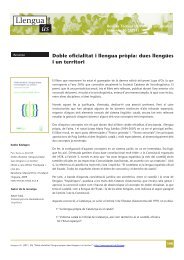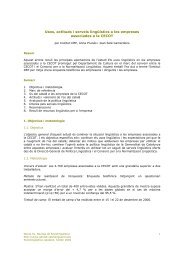Language Policy in the Russian Federation: language diversity and ...
Language Policy in the Russian Federation: language diversity and ...
Language Policy in the Russian Federation: language diversity and ...
Create successful ePaper yourself
Turn your PDF publications into a flip-book with our unique Google optimized e-Paper software.
summed up as follows: “La politique l<strong>in</strong>guistique est sans aucun doute le plus orig<strong>in</strong>al de l’action menée par<br />
le pouvoir en matière nationale. C’est aussi, cela est certa<strong>in</strong>, sa plus parfaite réussite 8 ”.<br />
Actually <strong>the</strong> different <strong>language</strong> policies implemented <strong>in</strong> <strong>the</strong> Soviet Union are for sure one of <strong>the</strong> most<br />
salient achievements of <strong>the</strong> regime <strong>in</strong>sofar as we can't detach <strong>the</strong>m from <strong>the</strong> political, social <strong>and</strong><br />
economic events which took place dur<strong>in</strong>g seven decades nei<strong>the</strong>r from <strong>the</strong> changes <strong>in</strong> <strong>the</strong> correlations of<br />
forces with<strong>in</strong> <strong>the</strong> top ranks of <strong>the</strong> State <strong>and</strong> of <strong>the</strong> federated republics. The changes <strong>in</strong> <strong>the</strong> demographic<br />
structure of <strong>the</strong> population dur<strong>in</strong>g <strong>the</strong> process of modernization of Soviet economy <strong>and</strong> society<br />
contributed likewise to streng<strong>the</strong>n, especially <strong>in</strong> <strong>the</strong> urban areas, <strong>the</strong> tensions raised by <strong>the</strong> contacts<br />
between <strong>language</strong>s toge<strong>the</strong>r with o<strong>the</strong>r factors as <strong>the</strong> size of l<strong>in</strong>guistic <strong>and</strong> national groups, <strong>the</strong><br />
experience (historical o recent) of contacts with o<strong>the</strong>r ethnic groups, <strong>the</strong> geographic location or concrete<br />
l<strong>in</strong>guistic, religious <strong>and</strong> cultural k<strong>in</strong>ships. Insofar as <strong>the</strong> policies implemented by <strong>the</strong> State <strong>in</strong> order to<br />
ensure <strong>the</strong> equality between nations were based on <strong>the</strong> Marxist-Len<strong>in</strong>ist <strong>in</strong>terpretation of <strong>the</strong> dialectical<br />
relations established between <strong>the</strong> different nationalities, <strong>the</strong> underly<strong>in</strong>g motivations of l<strong>in</strong>guistic <strong>and</strong><br />
national policies were that <strong>the</strong> modernization of <strong>the</strong> different ethnic groups of <strong>the</strong> USSR could not be<br />
achieved if <strong>the</strong> autochthonous populations didn't manage to reach a high level of literacy, culture <strong>and</strong> social<br />
<strong>and</strong> political consciousness. At <strong>the</strong> same time, <strong>the</strong> new needs of <strong>the</strong> Soviet society (<strong>in</strong>dustrialization,<br />
technologic challenges, build<strong>in</strong>g of socialism) required <strong>the</strong> creation of a new society with an adequate critical<br />
mass of <strong>in</strong>dividuals able to deal with new technical <strong>and</strong> <strong>in</strong>tellectual tools <strong>in</strong> order to implement <strong>and</strong> make real<br />
<strong>the</strong> projects designed by <strong>the</strong> State. On <strong>the</strong> o<strong>the</strong>r h<strong>and</strong>, <strong>the</strong> Socialist Revolution happened <strong>in</strong> a country which<br />
didn't possess <strong>the</strong> objective conditions for its consolidation - <strong>the</strong> structure of <strong>the</strong> population was<br />
overwhelm<strong>in</strong>gly formed by peasant, <strong>the</strong> urban proletariat was scarce, <strong>the</strong> level of <strong>in</strong>dustrialization still<br />
low accord<strong>in</strong>g to Western st<strong>and</strong>ards as well as <strong>the</strong> political <strong>and</strong> cultural development of <strong>the</strong> populationalthough<br />
<strong>the</strong> new regime managed to set up new structures of power after a long civil war.<br />
Never<strong>the</strong>less, <strong>the</strong> streng<strong>the</strong>n<strong>in</strong>g of <strong>the</strong> new State <strong>and</strong> <strong>the</strong> build<strong>in</strong>g of socialism required a radical change<br />
<strong>in</strong> <strong>the</strong> social, political, cultural <strong>and</strong> economic composition of <strong>the</strong> country. As far as <strong>the</strong> <strong>in</strong>dustrialization of<br />
<strong>the</strong> USSR was a s<strong>in</strong>e qua non condition for its own survival, <strong>the</strong> most effective <strong>and</strong> fast way to ga<strong>in</strong> <strong>the</strong><br />
support (or neutrality) of <strong>the</strong> non-<strong>Russian</strong> nationalities, as well as to <strong>in</strong>culcate <strong>in</strong>to <strong>the</strong>m <strong>the</strong> new political<br />
culture was to use <strong>the</strong> autochthonous <strong>language</strong>s as one of <strong>the</strong> ma<strong>in</strong> tools of this process of learn<strong>in</strong>g <strong>and</strong><br />
change. It was <strong>the</strong>refore necessary to set up a new educational system <strong>and</strong> new cultural, ideological <strong>and</strong><br />
communicative doma<strong>in</strong>s <strong>in</strong> different <strong>language</strong>s. This is <strong>the</strong> reason why <strong>language</strong> policy was from <strong>the</strong><br />
very beg<strong>in</strong>n<strong>in</strong>g one of <strong>the</strong> ma<strong>in</strong> cruxes of <strong>the</strong> Soviet policy towards nationalities. <strong>Language</strong> policy was<br />
carried on by <strong>the</strong> Narkomnats 9 by means of four ma<strong>in</strong> activities, namely: <strong>the</strong> selection of a st<strong>and</strong>ard<br />
code for every autochthonous <strong>language</strong> <strong>and</strong> its dissem<strong>in</strong>ation as a common <strong>language</strong> of communication<br />
for <strong>the</strong> populations of <strong>the</strong> autonomous territorial units; <strong>the</strong> modernization of <strong>the</strong> lexicon accord<strong>in</strong>g to <strong>the</strong><br />
needs of a modern <strong>in</strong>dustrial society; <strong>the</strong> reform or creation of new alphabets for <strong>the</strong> autochthonous<br />
<strong>language</strong>s; <strong>and</strong> <strong>the</strong> large-scale literacy campaign <strong>in</strong> <strong>the</strong> peripheral regions by means of <strong>the</strong> teach<strong>in</strong>g of <strong>the</strong><br />
autochthonous <strong>language</strong>s <strong>in</strong> new national school systems. As a long term result of this k<strong>in</strong>d of policies, at<br />
<strong>the</strong> end of <strong>the</strong> Soviet Union <strong>the</strong> overall picture of <strong>the</strong> sociol<strong>in</strong>guistic situation of both <strong>the</strong> autochthonous<br />
<strong>language</strong>s <strong>and</strong> <strong>Russian</strong> as <strong>the</strong> common <strong>language</strong> of communication between all <strong>the</strong> parts of <strong>the</strong> State<br />
was as follows:<br />
Ethnic groups, knowledge of <strong>Russian</strong> <strong>and</strong> of <strong>the</strong> <strong>language</strong> of <strong>the</strong> titular ethnic group (1989)<br />
Republic Majority groups (%) % Knowledge of<br />
<strong>Russian</strong><br />
Armenia Armenians (93)<br />
Azeris (3)<br />
Azerbaidjan Azeris (83)<br />
<strong>Russian</strong>s (6)<br />
Armenians (6)<br />
Belarus Belorussians (78)<br />
<strong>Russian</strong>s (13)<br />
Estonia Estonians (62)<br />
<strong>Russian</strong>s (30)<br />
Georgia Georgians (70)<br />
Armenians (8)<br />
<strong>Russian</strong>s (6)<br />
Azeris (6)<br />
Kazakhstan Kazakhs (40)<br />
<strong>Russian</strong>s (38)<br />
45<br />
19<br />
32<br />
--<br />
69<br />
80<br />
--<br />
35<br />
--<br />
32<br />
52<br />
--<br />
35<br />
64<br />
--<br />
% Knowledge of <strong>language</strong><br />
of titular ethnic group by<br />
o<strong>the</strong>r groups<br />
--<br />
7<br />
--<br />
15<br />
7<br />
--<br />
27<br />
--<br />
15<br />
--<br />
26<br />
24<br />
10<br />
--<br />
9<br />
8 Carrère d’Encausse, 1978:203.<br />
9 Narodnii Kommissariat po Delam Natsionalnostei [People's Commissariat for Nationalities Affairs].<br />
Noves SL. Revista de Sociol<strong>in</strong>güística 2<br />
http://www.gencat.cat/llengua/noves<br />
Sociol<strong>in</strong>güística <strong>in</strong>ternacional. Primavera 2002


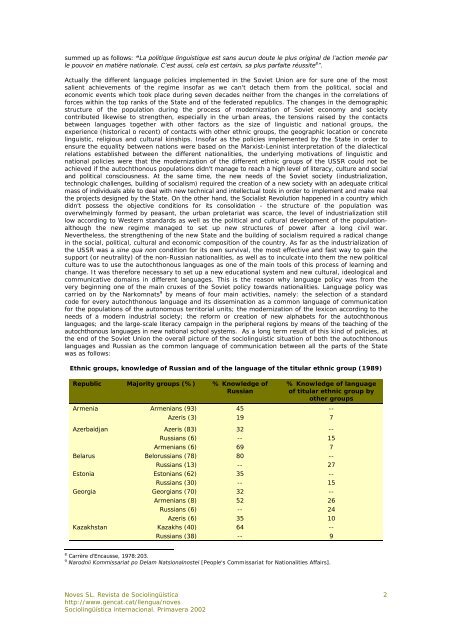
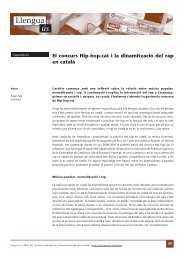
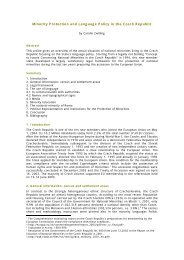



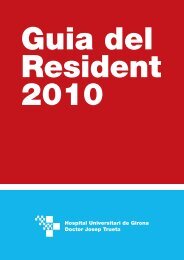

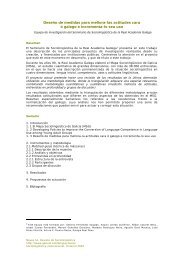
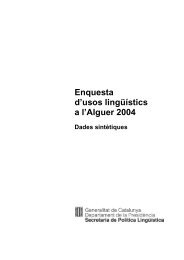
![Mestres, J.M. [et. al]. Manual d'estil: la redacció i l'edició de textos](https://img.yumpu.com/31252673/1/184x260/mestres-jm-et-al-manual-destil-la-redaccia-i-ledicia-de-textos.jpg?quality=85)
